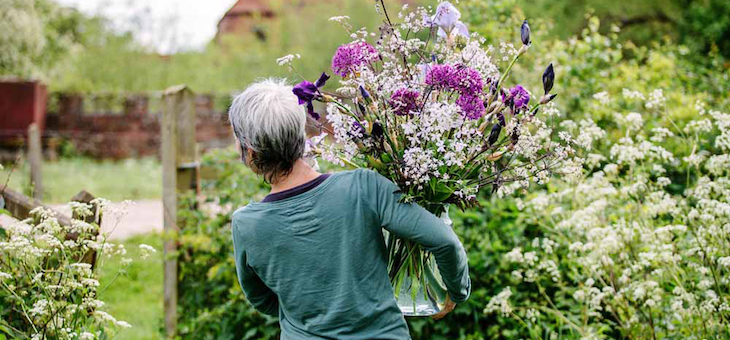Cut flowers bring cheer, whether in your kitchen, on your bedside table or dotted around your home – so it’s time to make a space in your garden for a flower patch so you can cut your own.
From spring bulbs such as narcissi, tulips and camassia, summer annuals and perennials including peonies, astrantia, delphiniums and roses, through to the asters, dahlias and sunflowers of late summer and early autumn, you can make the cut flower season last a long time.
Here, artisan growers of Flowers From The Farm share their secrets on how to grow beautiful blooms for cutting and keep them going strong once they’re indoors.
Know your soil
Ray Baxter, of Mill Pond Flower Farm, likes to demonstrate the ‘know-your-soil’ trick of mixing water with soil in a jar, shaking it and seeing how it settles into layers of sand, silt or clay.
“Understanding the properties of your soil is a really important consideration for growing just about anything. You need to understand how your soil holds on to nutrients and how it can hold on to moisture,” says Mr Baxter. “Thankfully, we can improve almost any soil by adding biomass. We do that by adding seaweed, weed from our pond and by adding lots of well-rotted manure.”
Start a compost heap
Cobi Snelson, of Batch Cottage Flowers, is a firm believer in the power of compost. In her cutting garden, she has six wooden composting bins on the go at any one time.
“We have lots of good ingredients for making compost here: donkey, sheep and chicken manure goes in along with shredded paper (which we think is the secret ingredient), along with cuttings from the garden and organic food matter, and occasionally some rainwater if it gets dry,” says Ms Snelson.
“We label them so we know when they’re ready – and they take up to a year to be ready. We don’t turn our compost, we just let time and the brandling worms and centipedes do the work.”
Form a plan
Keep your mobile phone on you in your garden to plan ahead, recommends Claire Brown, of PlantPassion, author of The British Flowers Book.
“I’m planning all the time. Your best tool when you’re in a garden is not a piece of paper that may blow away in the wind but a mobile phone. I put messages into my phone, telling it what I’ve got too much of, or what I’ve got too little of. That’s where my planning starts for the following year.”
Pack in perennials
Perennials, such as astrantia, eryngium, echinops, crocosmia and veronica, form the backbone of any cutting patch and make excellent cut flowers. Plus, they are low maintenance and come back year after year, says Rachel Siegfried, of Green & Gorgeous.
“We really pack the planting in to minimise weeds and create a close canopy,” she adds. “We can cut everything back in spring and use a loader to get the mulch directly onto the beds.”
Think succession
Two years ago, Kirsten Mackay, of Henthorn Farm Flowers, turned half her residential garden over to a flower-filled, super-productive cutting garden.
“I have a mixture of perennials, annuals and bulbs and shrubs that extend the growing season here. With the annuals, as soon as one thing’s going over, I want to have something ready to take its place,” says Ms Mackay.
“I grow annuals in seed trays so that I can plant the seedlings straight out into neat rows in cutting beds. Rows make weeding so much easier.”
Keep cutting
To get the most from your cutting plot during the summer months, Justine Scouller, of Far Hill Flowers, recommends growing ‘cut and come again’ flowers.
“Dahlias start flowering and as long as we keep cutting them, they flower again. Annuals such as cosmos, sweet peas, calendula and cornflowers produce a fantastic crop of flowers throughout the summer,” Ms Scouller says.
“Plant them closer in a cutting patch than you would do in the border, so that they grow tall and straight as they compete for sunlight and to reduce the need for weeding, and then just keep cutting them. The more flowers you cut, the more the plant will produce.”
Make them last indoors
When and how you cut the flowers can make a big difference to how long they last in the vase, says Carol Siddorn, of Carol’s Garden.
“Ideally, cut flowers first thing in the morning before it’s too hot but after the dew has gone from the flowers, as they take up water overnight and become more turgid.
“I cut them and put them straight into a bucket of water,” adds Ms Siddorn. “This prevents air bubbles from forming, especially in hollow stems. I don’t use flower food: we don’t need to extend the life of the flowers that much and I don’t like to use chemicals.”
Do you grow flowers specifically to cut? How often do you have cut flowers in the house?
– With PA
If you enjoy our content, don’t keep it to yourself. Share our free eNews with your friends and encourage them to sign up.
Related articles:
https://www.yourlifechoices.com.au/how-to-make-cut-flowers-last-longer
https://www.yourlifechoices.com.au/how-to–grow-edible-flowers
https://www.yourlifechoices.com.au/lifestyle/leisure/growing-tips-for-five-favourite-vegies

